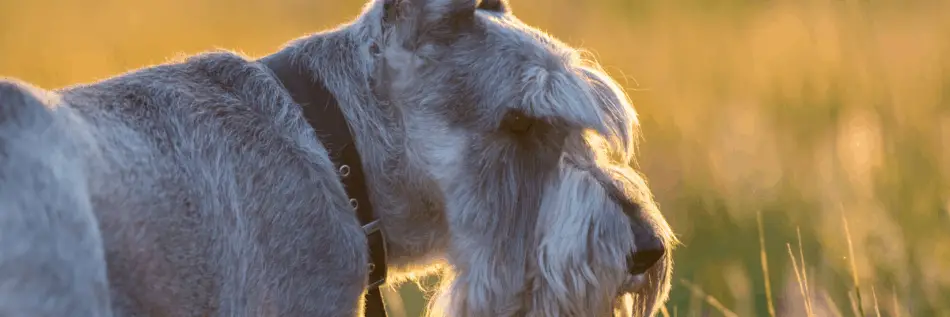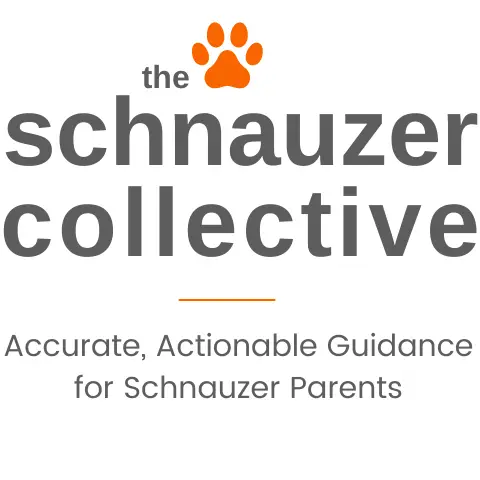
FAMILY FRIENDLY

INTELLIGENT

HEALTHY

EXERCISE NEEDS

GROOMING NEEDS

HYPOALLERGENIC









- Height: 23-28 inches
- Weight: 65-110 pounds
- Lifespan: 10-12 years
- Food: 4-5 cups each day, spread over two or more small meals
- Intelligence: Ranked in the top 35 of 140 dogs
- Popularity: Ranked 80th out of 190 dogs
Physical Description
Giant Schnauzers are large, imposing, distinguished-looking dogs. They have strong, well-developed muscles, square body frames, and a distinctly rectangular head. The muscular and robust body of the Giant Schnauzer portrays the breed as courageous and bold.
The Giant Schnauzer has a thick double coat. The undercoat is soft and dense, while the outer coat is wavy and somewhat bristly. A wiry, generally long beard and eyebrows are distinguishing Giant Schnauzer characteristics.
The coat colors can be a solid, pure black, or salt and pepper, which consists of banded black and white hair that creates a deep, medium-gray shade. The pepper and salt variety has a darker facial mask and lighter eyebrows, whiskers, and cheeks. Coat colors can also come in fawn.
A Giant Schnauzer’s ears may be cropped or left floppy and natural. His tail may be docked or natural. Meeting AKC breed standards and showing requirements include a docked tail.
Temperament
The Giant Schnauzer’s imposing size matches his spirited, domineering, but very loving temperament. This is a very loyal, protective breed. The Giant Schnauzer’s strong, complex temperament and sheer size requires an owner who can assert authority. Giants need firm training and early socialization, but are bred to do well within a family. Giant Schnauzers do not like being alone and usually prefer a special relationship and bond with their human companions.
Here are several specific layers to a Giant Schnauzer’s general temperament.
Temperament: Guard Dog Instincts
Giant Schnauzers were originally bred to be large, domineering working dogs who were trained to herd sheep and cattle. They were expected to guard livestock and farm families, and to keep their owners safe as they traveled from one place to another.
As such, Giant Schnauzers can be territorial of their surroundings and protective of their human family. While they are not bred to be overly aggressive, Giants will bark and may seem somewhat threatening to strangers or unfamiliar animals.
Within their guard dog instincts, however, they can be trained and socialized to blend well into most families. Their sheer size makes them a force to be reckoned with, but they are naturally loving animals.
Temperament: Family and Other Pets
Giant Schnauzers are genetically inclined to be with a human family. Stemming from their early days serving on German farms and due to breeding for a specific role and temperament, Giant Schnauzers thrive within an active, loving family environment.
Read my article Are Schnauzers Affectionate? for additional family information.
Giant Schnauzers are naturally protective of their human families and crave human interaction. Because they are an intelligent breed, they can be a little bossy and stubborn, but early training and socialization will help.
How Are Giant Schnauzers with Kids?
Giant Schnauzers might be overwhelming to small kids simply by virtue of their towering size. However, they are not overly aggressive dogs and do not deliberately hurt people unless threatened. You will always want to supervise a Giant Schnauzer when it is with very small children, just to be safe. However, because Giants need a lot of physical exercise, play, and mental stimulation, they are perfect for older kids who can take on the responsibility of walking them, playing with them, and teaching them new skills and sports.
How Are Giant Schnauzers with Aging Adults?
Giant Schnauzers can also be great companions for aging adults. As affectionate guard dogs, Giants can provide company, emotional support, peace of mind, and even physical support. They can also be trained as therapy dogs and certified as service dogs. The primary drawback is their size. For some aging adults, a Giant Schnauzer might be too large to handle effectively and safely.
Read my article Can Schnauzers be Therapy or Service Dogs? for additional details.
How Are Giant Schnauzers with Other Pets?
If trained and socialized early, Giant Schnauzers can do fairly well with other dogs and even cats. However, their guard dog instinct and size must be taken into consideration. Giant Schnauzers can be quite territorial if they are not socialized to other animals and pets early, and their large stature and strength make them potentially dangerous to small pets.
Check out my article Do Schnauzers Get Along with Other Dogs (And with Cats?) for some insights into Standard Schnauzers and other animals.
Socialization
The best way to ensure that a Giant Schnauzer does well with the other people and animals in your life is to train and socialize early.
Begin socializing a Giant as early as possible by introducing him to a range of people and experiences.
Socialize him in a wide variety of ways by getting out to parks, trails, pet-friendly events, and pet-friendly buildings where he will encounter people. Continue inviting friends and family to your home. Let them know that you have a Giant Schnauzer and that it may take a few visits before he warms up to them.
Intelligence
Giant Schnauzers are currently ranked as the 35th most intelligent dog breed out of a total of 140 breeds. Giants learn quickly, and can be very obedient dogs when they are kept mentally and physically active. Giants are placed in the category of the above-average smart dogs, which means that the Giant Schnauzer can learn new commands with between 15 to 25 repetitions, and generally obeys known commands with a success rate of 70% or better.
However, intelligence comes with some potential drawbacks such as willfulness. Early, consistent, and firm but positive training will ensure that a Giant Schnauzer’s intelligence is channeled in healthy and mutually enjoyable and productive ways.
Read my article Are Schnauzer’s Smart? How to Tell and 5 At-Home Tests for more information.
Best Living Conditions
The Giant Schnauzer is intended to live indoors with a family. A Giant can be left alone for an hour or so if they are fully crate trained and left with moderately challenging dog toys. However, Giants are large, intelligent, busy, active dogs and can easily become bored and destructive.
The Giant Schnauzer needs abundant room to roam and play. Giants are somewhat boisterous, playful, and extremely energetic. He does not do well alone for very long, and will need an hour or two of exercise each day. As a result, Giants are not a good fit for small spaces, families who are away all day, or anyone is who not willing or able to keep up with this large breed.
Access to trails, open spaces, or dog parks is ideal. In addition, a fenced yard is usually recommended because they are known to jump a six-foot fence.
Whatever its environment, the Standard Schnauzer should live with its human family.
Training
Ranked as an above-average intelligent canine breed, the Giant Schnauzer can generally learn new commands within 15-25 repetitions. As highly energetic working dogs, Giant Schnauzers enjoy both the mental and physical challenge of learning new skills.
In addition, the bold and imposing Giant Schnauzer needs to know who is in charge. Any serious owner who wants a good experience with a Giant will need to begin training early, be consistent, establish authority, and employ firm, but positive training.
Basic Commands
The 16 basic commands below are essential skills a Giant Schnauzer can and should have. Enlisting the help of a professional trainer or purchasing a training program can provide a solid, successful start.

Keep in mind that training these skills should be for respect and obedience, not just for fun:
| Watch Me | Wait | Off | Settle |
| Sit | Down | Leave It | Place/Bed/Crate |
| Stay | Heel | Take It | Stand |
| Come | No | Drop It | No Pull |
Training Tips
Scheduling a series of sessions with a professional dog trainer may give you the confidence and first-hand training observation you need to continue training your Giant Schnauzer for life.

Whether you involve a professional trainer or not, here are some basic training tips:
- Find a quiet, private location with no distractions
- Show him exactly what your want him to do
- Teach one command at a time and move to another command only when he has mastered the first one
- Reward progress with small treats
- Don’t punish him for mistakes
- Keep the training sessions short and simple
- Be patient and consistent
- Stay upbeat and positive
- Keep trainings fun and full of encouragement
- Include play sessions after the training to keep training associated with fun and loving interaction
Respect Training
Giant Schnauzers are intelligent, large, and active enough to be hard to handle if they are not trained to respect you when they are puppies. Because of their size and strong personality, Giants Schnauzers absolutely need to respect their human caretakers and know who is in charge. The training can be positive, but firm and consistent. Consider partnering with a professional trainer early in the process.
Sport Training
Giant Schnauzers were bred primarily as herders and guard dogs. They are large, trainable, intelligent, and alert with an aptitude for police, military, and rescue work. They thrive when then are given tasks and assignments. Always eager to learn and please, they benefit from an extremely high level of activity.
Giant Schnauzers are extremely agile, strong, and have excellent endurance. Giants have a running speed of 28 MPH and a jumping height of 4-6 Feet.
They excel at many canine sports such as Dog Carting, Herding Trials, and Lure-Coursing.
Read my article What are the Best Sports for Schnauzers? for a comprehensive list of sports and for ways to keep your athletic Giant Schnauzer healthy.
Therapy and Service Training
Schnauzers have therapeutic effects on the physical and psychological conditions people might experience. They are loving and intelligent, and can be trained as either therapy or service dogs.
As large, well-trained therapy dogs, Giant Schnauzers can bring comfort and affection to people in health institutions, schools, retirement homes, among other places. As excellent service dogs, Giants can help physically challenged people to live a more independent and freedom-filled life.
For more details on how Giant Schnauzers can serve in these capacities, read my article Can Schnauzers be Therapy or Service Dogs?
Grooming
Giant Schnauzers have consistent grooming needs. Keeping up on basic grooming tasks will ensure that he is maintained well and that any health issues are caught early.
Hypoallergenic Coat
The Giant Schnauzer is born with a double, wiry coat and is considered to be hypoallergenic. Their covering is more like human hair than animal fur, and they don’t shed any more than a human being does.
This keeps pet dander to a minimum and is perfect for anyone with allergies. However, it also means that the Giant needs to be brushed and groomed regularly.
The Giant Schnauzer will need its longer hair brushed several times a week, and the beard should be cleaned and brushed daily. He should be fully bathed weekly unless it seems like the skin is becoming dry and flaky.
This breed’s coat must be hand-stripped at least every four to six months if you like the look and feel of its original coat or decide to show your dog.
However, if you are not interested in having a show dog, it is also an option to use clippers to shave the outer coat. Using clippers to remove the outer, wiry coat is becoming a more popular option because it reveals the softer undercoat. If you are not showing your Giant, how you groom his coat comes down to personal preference.
Teeth
Historically, all Schnauzer breeds have teeth that are more susceptible to periodontal disease than other dog breeds. Without regular brushing, tartar and plaque will accumulate leading to tooth decay, infections, bad breath, gum disease, tooth loss, and gingivitis. When left untreated, gingivitis can progress into periodontal disease leading to severe health problems.
According to the American Veterinary Dental Society, 80% of canines develop periodontal illness by the age of three. The Giant Schnauzer’s gums will start breaking down due to periodontal disease, increasing the risks of harmful bacteria entering the bloodstream. Once bacteria enter the bloodstream, the immune system may be compromised and can eventually lead to organ failure.
In addition, Giant Schnauzers with poor dental hygiene are more prone to eye problems, joint problems, liver disease, kidney disease, and heart disease.
It is necessary to brush a Giant’s teeth several times weekly, preferably daily. Chew toys and an enzymatic water additive formulated to help reduce tartar can help with hygiene. An annual periodontal examination by his veterinarian and possibly a professional veterinary cleaning (which requires full anesthesia) are basic recommendations.
How To Clean Your Schnauzer’s Teeth
Brushing your dog’s teeth is one of the most significant things you can do to prolong the pet’s life. Doing it every day will help prevent the accumulation of tartar and plaque, which might otherwise develop into periodontal disease. You should start brushing the teeth of your Schnauzer daily when it’s a small puppy. That will assist in stimulating its gum lines and also help it become comfortable and accept the process of having regular dental cleanings.

Here is a step-by-step guide on how to clean your Schnauzer’s teeth.
| 1. Set a specific time during the day | Choose some time during the day that works best for you, but it’s always a good idea to set a time of day when your dog is relaxed and calm. Whatever time you select, try, and keep it as part of your routine each day because cleaning dog teeth daily is the most effective to maintain good dental health. |
| 2. Choose a comfortable spot | Select a convenient location for both of you. For instance, you can have your dog lie on a couch or the bed. That way, you can easily clean one side of its mouth and then turn it over to brush the other side more easily. |
| 3. Collect your brushing tools | Make sure you have everything ready before you begin brushing your schnauzer’s teeth. Apart from the toothbrush and toothpaste designed for canines, you can also have a washcloth to help you hold back the wet open mouth of your dog. Note: Only use a canine-approved toothpaste! Canine toothpastes are formulated to be safe for dogs and swallowed without causing harm. Human toothpaste is toxic for your Schnauzer. |
| 4. Inspect your Schnauzer’s teeth | Begin the cleaning process by giving your dog a good oral examination. Lift the lip of your Schnauzer and look at its teeth. Check for any signs of tartar, plaque, gum disease, or tooth decay. |
| 5. Inspect your Schnauzer’s mouth | Place your thumbs gently on either side of the Schnauzer’s muzzle and lightly stoke downward. Check if there any abnormalities or lumps. Also, check the gum lines of your dog. The gums should not be swollen and must be pink in color, not red. |
| 6. Begin brushing his teeth | 1. Put a small amount of gel or toothpaste on the finger brush or toothbrush. Next, pull the corner of your dog’s mouth backward using your thumb to lower and press down the bottom lip and your index finger to raise the top lip. 2. Start brushing at the back of its mouth and begin with gentle back-and-forth strokes. Avoid applying too much pressure because it can cause damages to the gum line, making your Schnauzer squirm to get free. 3. Utilize light pressure at all times because you want your pet to accept the cleaning process. Clean the upper and lower teeth, spending 30-40 seconds on each section. |
If your Schnauzer pulls away in pain or his gums bleed at all during the brushing process, make an appointment with your veterinarian as soon as possible.
Read my article Your Schnauzer Has Genetically Bad Teeth! (What to Do) for details on periodontal disease and how to take care of your Schnauzer’s teeth.
Eyes and Ears
A Giant Schnauzer’s eyes and ears are two of his most important and excellent senses. Checking them regularly and keeping them healthy is critical.
Eyes
Schnauzer eyes tend to build up black discharge at the inner corners and they need to be gently washed with warm water and a cloth nearly daily. Read my article Why Does My Schnauzer Have Eye Gunk (And What to Do) for details. Giant Schnauzers are also prone to specific eye problems, such as cataracts. The eyes should be inspected regularly to catch health problems early. Read my article Can Schnauzers Get Cataracts (10 Eye Problems to Know About!) for important information.
Ears
Giant Schnauzer ears can either be left natural and floppy or they can be trimmed (docked) when they are very young. Either way, they need to be inspected and gently washed regularly to keep moisture, dirt, earwax, and ultimately, bacteria at bay. Some owners and groomers even pluck the ear hair as part of normal grooming, although if the ears are healthy there is no medical reason to do this. Read about this somewhat controversial practice, along with basic ear hygiene in my article Should I Pluck My Schnauzer’s Ears (If so, Why and How?).
Health
The Giant Schnauzer is second-oldest of the Schnauzer breeds (the Standard is the original and oldest). The Giant’s origins trace back to early Germany and has a lifespan of 10-12 years, but can live as long as 16 years. As a very large, purebred dog, the Giant Schnauzer has some genetic health issues such as Gastric Torsion, Osteochondrosis Dissecans (OCD), and Hypothyroidism. This breed may also suffer Canine Hip Dysplasia which is a significant health concern for any dog breed.
Keeping up a healthy diet, exercise, vaccinations will help to extend the length a quality of a Giant Schnauzer’s life.
Immunizations
All canine immunizations fall into two categories: Core and Non-Core.
All dogs are required to stay on a core vaccination schedule.
The non-core vaccinations are optional depending on your Giant Schnauzer’s particular health risks, and your veterinarian can provide some guidance.
Core vaccinations include:
- Canine DAP (Distemper, Adenovirus, Parvovirus)
- Canine Rabies vaccine
Non-core, optional vaccinations include:
- Bordetella Bronchiseptica vaccine
- Parainfluenza vaccine (often combined with either the Bordetella or the DAP vaccines)
- Canine Influenza vaccine (H3N2 and/or H3N8)
- Leptospirosis vaccine
- Lyme vaccine
Giant Schnauzer Puppy Immunization Schedule
| AGE | CORE VACCINES | NON-CORE VACCINES |
|---|---|---|
| 6-8 Weeks | – DAP | – Bordetella – Parainfluenza (often included in DAP combo vaccine) |
| 10-12 Weeks | – DAP | – Leptospirosis – Lyme – Canine influenza |
| 14-16 Weeks | – DAP: Generally given 16 weeks or later – Rabies vaccine: Some states may require it to be given earlier. Check with your state. | – Leptospirosis – Lyme – Canine influenza |
Giant Schnauzer Adult Immunization Schedule
| TIMEFRAME | CORE VACCINES | NON-CORE VACCINES |
|---|---|---|
| Annually | None, although some states require annual rabies shots. Check with your state. | – Leptospirosis – Lyme – Canine influenza – Bordetella (sometimes every 6 months) |
| Every 3 Years | – DAP – Rabies (check with your state) | None |
Primary Health Concerns
One of the best ways to keep your Giant Schnauzer healthy is by taking him for regular thyroid and hip examinations. Studies by Michigan State University have reported approximately 23% of Giant Schnauzers to have thyroid disease.
Orthopedic Conditions
Orthopedic health problems, especially Hip Dysplasia, are the most reported health concerns among Giant Schnauzers. Other orthopedic diseases affecting Giant Schnauzers include Hypertrophic Osteodystrophy, Osteochondritis, and Panosteitis. All of these conditions result in lameness and pain.
Eye Problems
Giant Schnauzers also suffer eye problems. Retinal Dysplasia and Progressive Retinal Atrophy (PRA) are some of the common eye conditions affecting Giants. They also prone to cataracts that may develop while they are still a puppy or at the age of 6-7 years.
Additional Giant Schnauzer Health Concerns
Similar to most deep-chested dog breeds, Giant Schnauzers are susceptible to bloat, which is an emergency gastrointestinal condition. This breed may also have an issue with blood clotting, especially Thrombocytopenia and Willebrand’s Disease. Giant Schnauzers may also suffer from skin diseases such as Vitiligo, Seborrhea, and allergies.
Some Giant Schnauzers have an issue in producing Vitamin B12, which is vital for body and brain function. These dogs become disoriented and weak; thus, there are needed to supplement the vitamin to keep the dog healthy.
Other common health issues affecting Giant Schnauzers include:
- Heart Disease
- Autoimmune Hemolytic Anemia
- Epilepsy
- Digital Squamous Cell Carcinoma (Toe Cancer)
The Costs of Owning a Giant Schnauzer
Initial Purchase
The initial purchase of a Giant Schnauzer can range approximately between $1,300 to over $5,500.
The initial cost depends on what you are looking for in this breed. If you are looking for a superior pedigree and breeding lines for the purpose of having breeding rights or purchasing a show-worthy Giant, expect to pay a premium.
Median Price: $1,300.00
Average Price: $1,000.00
Top Quality: $2,100.00 to $5,500.00 +
Annual Costs
The annual costs below are approximate and do not take into account price fluctuations over time or variations in your geographical location.
The costs include ranges representing personal purchase preferences and the varying cost of services depending on the service provider you choose.
| Spay/Neuter | $100 (one-time cost) |
| Vaccinations | $100 |
| Annual Checkup | $150 |
| Dental Cleaning | $300+ (as needed) |
| Flea, Tick, and Heartworm Medication | $300 |
| Health Remedies and Supplements | $50-$250 |
| First Aid and Misc. Hygiene Supplies | $50-$100 |
| Grooming | $700+ |
| Quality Food | $700+ |
| Insurance | $30-100 |
| Microchip & Monthly Service | $45 for Microchip, then $45-$120 annual registry fee |
| Training | $100-$1,200 + (as needed) |
| Crate, Kennel, Carrier | $35 (basic) to $1,500+ (decorative) |
| Gates | $35-$150 |
| Bed | $35 (basic) to $1,500+ (decorative) |
| Collar, Leash, Tags | $35-$100 |
| Toys, Sports, Treat Puzzles | $35-$300 (oftentimes a one-time purchase) |
| Treats | $35-$100 |
| Wireless Fence | $200-$300 (one-time purchase) |
| Misc. Expenses | $50-$100 |
In addition to the ongoing, essential costs of owning a Giant Schnauzer, keep in mind that injuries and unexpected health issues can arise. The veterinary and animal hospital care for these situations can range between $500-$5,000 depending on the needed medical treatment.
As a very large, pure breed dog, Giant Schnauzers are good candidates for pet insurance due to known health issues. Although Giants are moderately healthy, having pet insurance can give you peace of mind.
Selecting a Reputable Breeder
Giant Schnauzers are expensive breeds and come with significant responsibility. The decision to select a breeder and purchase a Giant are important. You can consult the American Kennel Club for a list of registered breeders near you to begin your search.
It is also wise to continue learning about Giant Schnauzers so that you can ask informed questions of breeders. Reputable breeders will be more than willing to meet with you, answer all of your questions, and let you interact with the dogs.
A reputable breeder will also have proof and documentation of the Schnauzer’s lineage, genetic health screenings, and immunizations or training already completed.
Selecting a Veterinarian
The American Animal Hospital Association (AAHA) evaluates veterinary practices on the quality of their facilities, staff, equipment and patient care. Look to the association for a list of accredited vets in your area. In addition, you should start looking for a veterinarian before you even purchase a Schnauzer.
You will want to ensure that the veterinarian is licensed by the AAHA and has a good track record of patient reviews and feedback. You should also visit several veterinarian offices so that you a some comparison points. Ask about what services they provide, the level of expertise of their staff, and which services they can provide at their office as opposed to at an animal hospital. Be sure that the office is clean and well-maintained, and that it feels like a good fit for you and your Schnauzer. You can also change veterinarians if you are not happy with their service.
Breed History
Historical Details
Of the three Schnauzer breeds, the Giant Schnauzer is the largest. This breed is believed to have its roots in the Southern Bavaria region of Germany, and the American Kennel Club has officially recognized the breed for close to 50 years. The Giant Schnauzer can be traced to at least the 16th century.
Giant Schnauzers area crossbreed of the Standard Schnauzer, the Bouvier des (Flanders cattle dog), and the Great Dane. There is also a possibility that the Shepherd and Drover dogs are included in this mix.
Historically, Giant Schnauzers were used as a drover by cattle and sheep farmers to guide their animals; they were also used as guard dogs and have served in the police and military forces. During the Second World War, the Giant Schnauzer had extensive roles in the German military due to their intelligence, size, versatility, and training capabilities.
The Giant Schnauzer was introduced to the United States after World War I, and even the United States military employed Giants in various capacities during World War II.
Although the American Kennel Club recognized Giant Schnauzers during the 1930s, the breed standards for the Giant Schnauzer were not finalized until the 1970s. Although Giant Schnauzers are still quite rare as pets in the United States, their popularity has risen in the past few decades.
Current-Day Roles
Presently, Giant Schnauzers continue to play an important role in human life. Although they are a much more domesticated indoor dog, Giants are still considered to be a working breed. They love a good, active, job that is both physically and mentally stimulating. Giant Schnauzers are currently trained as Search and Rescue animals, Service and Therapy dogs, and lend their skills in drug and bomb sniffing scenarios as well as sometimes being trained specifically to detect disease.
And finally, from one pet parent to another, discover my all-time favorite resources designed to cover your every Schnauzer need. I’ve done the legwork for you so you can spend more time with the people and fur friends in your life.
A portion of all profit earned on this site is donated to Pet Partners
whose mission is to improve human health and
well-being through the human-animal bond.
They train and register pets to become therapy animals,
and have local chapters in many states.
